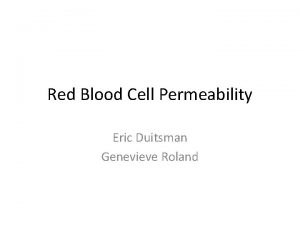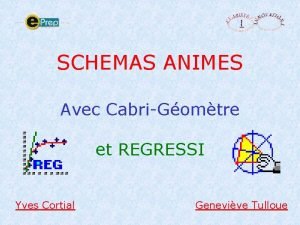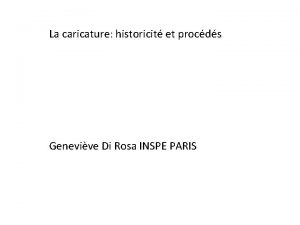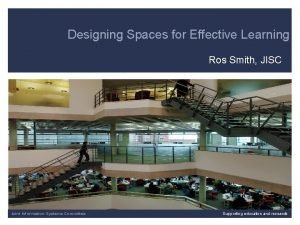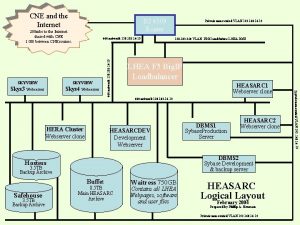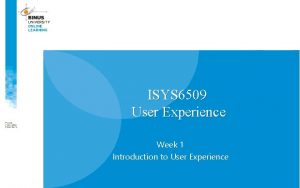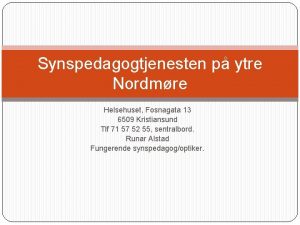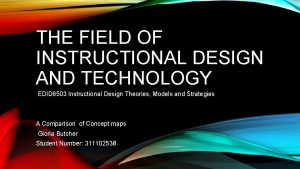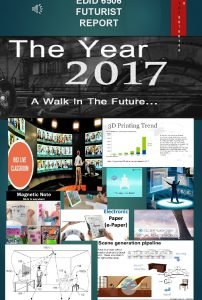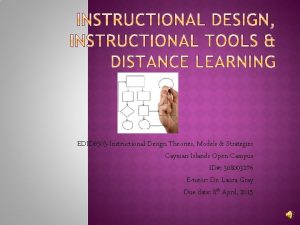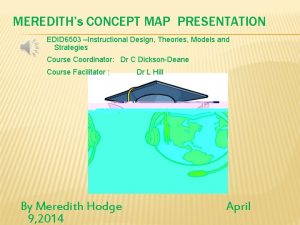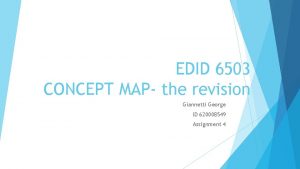EDID 6509 Designing Learning and Performance Solutions Genevieve














- Slides: 14

EDID 6509: Designing Learning and Performance Solutions Genevieve Cox Gloria Butcher Rachele Wagstaffe Ayanna Phillips-Stewart Nyeisha George-Minott

Introduction ● Problem Solving Learning (PSL) is based on the assumption that problem solving is a dynamic process where problems vary. ● PSL assumes that different kinds of problems require different problem solving skills and instructional support should vary accordingly.

Background/Problem ● It is widely viewed by many that Mathematics is a challenging subject. ● The problem of providing effective instruction and quality learning in mathematics has been one of the major challenges and concern to educators. ● There is a need to shift from teaching problem solving as a single component to teaching math concepts via problem solving in open-ended virtual centers ● Such a learning endeavor can offer different channels to improve mathematical problem solving skills in grades 4 and 5 students.

Theories and Models for Design Decisions The following theories and models were used as a guide for the development of the design solution: ● ● ● Case Based Learning Project Based Learning Inquiry Based Learning/Just in Time Teaching Collaborative Learning Social Constructivism


Alternative Solutions- Gloria ● Create virtual mathematics problem solving centers which provides opportunity for students to explore and construct their own knowledge. ● Centers will be managed in Moodle. ● Virtual centers in Moodle will also allow students to interact with other students as well as an instructor and provide opportunity for collaboration. ● Using Moodle will allow content to be updated frequently without the cost hassle and provide easy access to open source resources and systems such as Second Life.

Alternative Solutions- Rachele ● The instructional designer will create a series of games including board games, puzzles, video. ● Games provide an excellent environment to explore ideas of higher level thinking. ● Available both online and in non-computerized form helps to make this learning environment engaging. ● Popular tool used in classrooms to promote students’ mathematics achievement in various mathematical strands.

Alternative Solution- Ayanna ● The instructional designer will develop a series of cases using real world problems case scenarios to teach problem solving skills. ● This would be done using a Screencasting software Captivate. ● One Screencast video presentation per Mathematical topic. ● Students will problem solve all case studies in groups of four-five. ● They would have the option to re-play the problems as they go about “solving” the Mathematics scenarios. ● An answer booklet would accompany this Screencast case study. ● Worked solutions in booklet which would then be reviewed by class teacher.

Alternative Solution- Genevieve ● Inquiry learning to encourage reflection on math problem solutions ● Engage students in cognitivist constructivist web warm up activities prior to introducing math concepts and principles in class ● Allow students to analyze, evaluate and interpret individual understanding of math computation and concepts ● Use feedback from pre class web warm up assignments to scaffold students at their zone of proximal development in higher order thinking tasks ● Use clickable book, video playlist and other multimedia content to complement Just in Time Teaching through active learning approaches ● Provide structured activities to construct new knowledge from prior learning

Alternative Solution: Nyeisha ● Project based learning creates a constructivist approach to learning ● Within the classroom or online environment a math problem or challenge is set in the real world setting ● Students will design the process of reaching the solution by examining the task from different perspectives and using a variety of resources ● Students learn a variety of skills which include: communication, organization , research, critical thinking , leadership and self assessment

Chosen Solution ● Develop a mobile app that reflects an eclectic blend of theories and models utilized in PSL. ● Math-M-Matik will function in an online environment as a virtual learning center ● Users can learn about fractions, decimals , measurements, percentages and geometry ● Users have felxibility and can choose to learn the various topics by: ○ Watching tutorial videos ○ Play interactive games ○ Interact with a storybook ○ Performa an experiment ○ Experience real world scenarios

Math-M-Matiks

Brief Overview of Prototype The design of the prototype will incorporate features and buttons that allows the students to interact with various math problem solving operations in an online environment. Buttons that are clicked to go to the learning content will introduce the student to an interactive content learning space. The content will consist of quizzes, puzzles, board games and a clickable book, as well as a playlist of videos on the math topics. Buttons on the prototype will allow students to collaborate, discover, explore, and navigate in the virtual learning environment. Students will be enabled to apply concepts and principles learned from interacting with the content online to real world problem solving scenarios in the classroom environment.

 Genevieve roland
Genevieve roland Gnuplot matplotlib
Gnuplot matplotlib Marie-geneviève navarre
Marie-geneviève navarre Genevieve carlson
Genevieve carlson Geneviève tulloue
Geneviève tulloue Genevieve durigon
Genevieve durigon Geneviève di rosa
Geneviève di rosa Genevieve was obsessed with details
Genevieve was obsessed with details Genevieve quintin
Genevieve quintin Genevieve lennon
Genevieve lennon Genevieve koehler
Genevieve koehler Geneviève bourque
Geneviève bourque Designing performance tasks
Designing performance tasks Cuadro comparativo e-learning b-learning m-learning
Cuadro comparativo e-learning b-learning m-learning Designing spaces for effective learning
Designing spaces for effective learning
